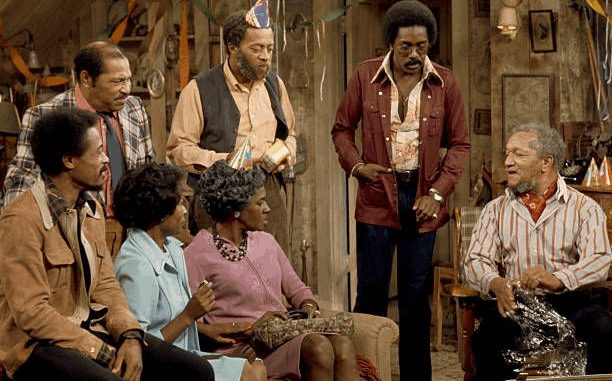
When Sanford and Son first aired in 1972, it seemed like just another sitcom with a catchy theme song, clever one-liners, and a unique father-son dynamic. But the laughter that rang out from millions of American living rooms masked the tension, secrets, and controversies that simmered beneath the surface. For six seasons, Fred Sanford (played by Redd Foxx) and his long-suffering son Lamont (Demond Wilson) kept viewers in stitches. Yet behind the scenes, it was a very different story—one that remains largely untold even today.
This is the true, raw, and revealing story of Sanford and Son—how one of television’s most iconic sitcoms nearly unraveled from the inside, how ego and personal demons shaped the show’s path, and how some of its most unforgettable moments almost never made it on air.
The Chemistry Was Real—But So Was the Conflict
Redd Foxx and Demond Wilson had chemistry on screen that was undeniable. Foxx’s grumpy, scheming Fred and Wilson’s grounded, eye-rolling Lamont mirrored a generational clash that resonated with millions. But what fans didn’t know was that while they played a loving (if dysfunctional) duo on screen, their relationship off-camera was far more complicated.
According to interviews and Wilson’s later memoir, the two had major disagreements over salary, respect, and treatment on set. Wilson claimed that producers played favorites and gave in to Foxx’s demands while sidelining him. In one instance, Foxx walked off the set mid-season due to a contract dispute—and didn’t return for several episodes. During that time, Wilson was expected to carry the show alone. The tension between them only worsened, to the point that by the final season, they were reportedly barely speaking outside of takes.
Despite this, their natural rhythm made every scene shine. The very friction that caused their off-set struggles may have been the magic behind their on-screen fire.
Foxx’s Demons: Fame, Finances, and a Tax Scandal
Redd Foxx was already a household name before Sanford and Son, famous for his raunchy stand-up routines and unfiltered comedic style. But fame came with a price. He was notorious for his extravagant spending—lavish cars, jewelry, and homes. During the height of the show, he was reportedly earning $25,000 per episode (a huge sum for the 1970s), yet within a few years, the IRS had seized nearly everything he owned.
His tax troubles became so severe that the IRS once raided the set of his later show, The Royal Family, seizing his property in front of cast and crew. But those issues were already taking root during Sanford and Son, leading to production delays, legal issues, and an air of unease that producers tried desperately to contain.
Demond Wilson’s Secret Descent and Sudden Disappearance
While Foxx was battling external chaos, Demond Wilson was struggling with internal demons. He later revealed in his autobiography that he had fallen into drug use during the series’ run. The pressure of fame, the sense of being sidelined creatively, and his own spiritual emptiness led him down a dark path.
Wilson never returned for the 1980s revival attempt, Sanford, and refused to appear in reunions or documentaries. Instead, he walked away from Hollywood entirely, turning to religion and becoming an ordained minister. Fans were stunned. One of TV’s most recognizable faces simply vanished from the screen.
Controversial Jokes and “Lost” Episodes
Sanford and Son pushed the envelope with its humor—often walking the fine line between satire and offense. Some episodes were banned or heavily edited in syndication due to language, racial slurs, and edgy material that would never fly today.
One particularly controversial episode involving interracial dating was pulled from several regional broadcasts in the South. Another episode, “The Masquerade Party,” featured themes around cross-dressing and sexuality—taboo topics for 1970s television. Though the show was lauded for its courage, it also faced heavy backlash, and some of these episodes were quietly removed from rerun rotations for decades.

There’s even talk among collectors of a “lost” episode that was filmed but never aired due to Foxx’s refusal to perform a script he found disrespectful. That episode has never surfaced—and NBC has refused to confirm its existence.
The Legacy That Refused to Die
Despite its short run—only six seasons—Sanford and Son left a lasting imprint on American pop culture. It opened doors for Black-led sitcoms, broke down barriers in prime-time television, and proved that diverse stories could dominate ratings.
Yet, its legacy is complicated. While it brought joy and laughter to millions, it also exposed the deep cracks in how stars were treated, especially Black actors in the entertainment industry. Redd Foxx died nearly penniless, and Demond Wilson, once a rising star, left the business entirely.
Even now, streaming platforms censor some original content from the show, fearing backlash from modern audiences. But for those who remember, the raw, unfiltered brilliance of Sanford and Son cannot be denied.
Conclusion: Laughter and Pain Behind the Scenes
Sanford and Son wasn’t just a sitcom—it was a revolution wrapped in jokes and junkyard scraps. Beneath the laughs were stories of struggle, betrayal, redemption, and resistance. For every gag Fred Sanford cracked, there was a real-life cost behind it. For every time Lamont rolled his eyes, there was an actor grappling with identity and purpose.
The junkyard may be closed, the characters long gone, but the truths behind the show still echo loudly—just waiting for the next curious viewer to dig them up.
